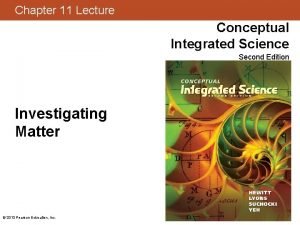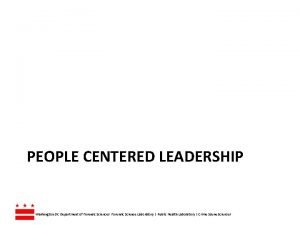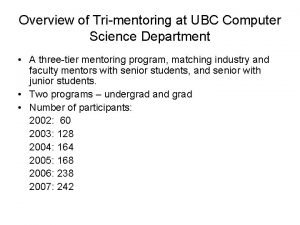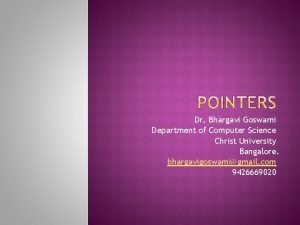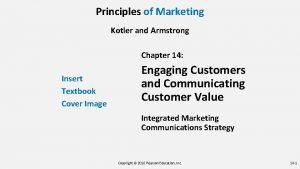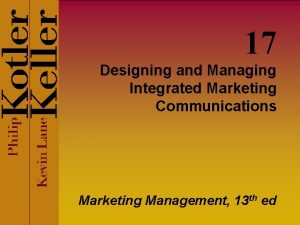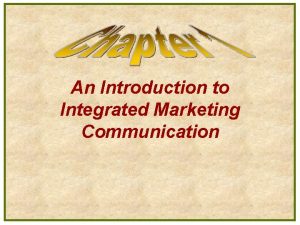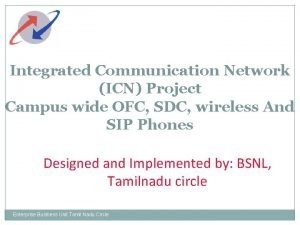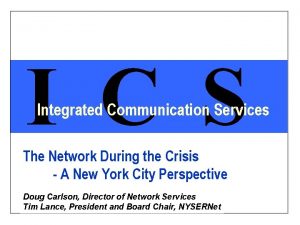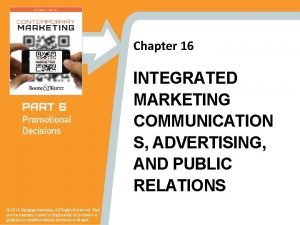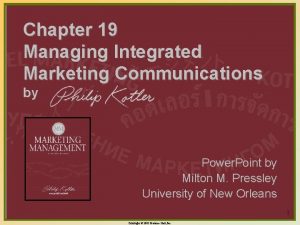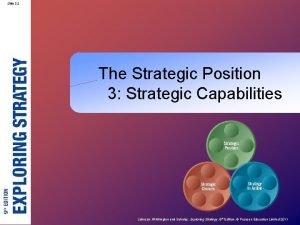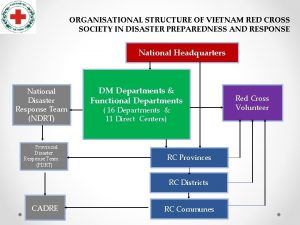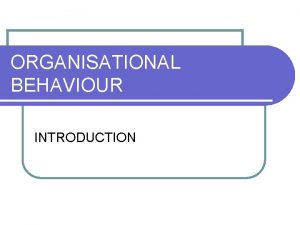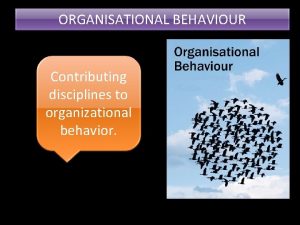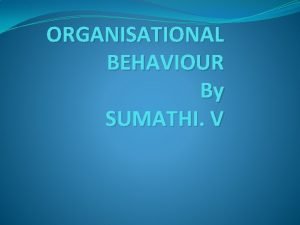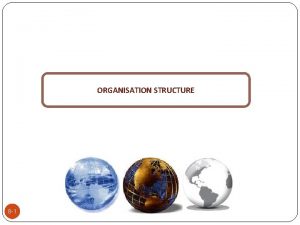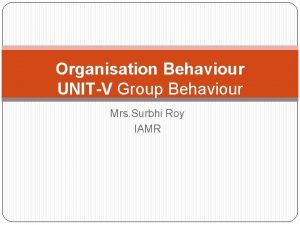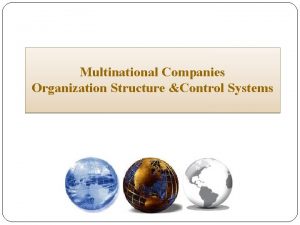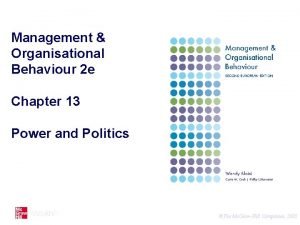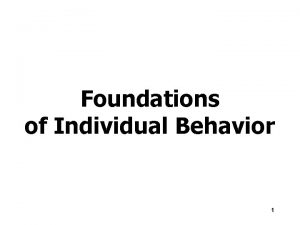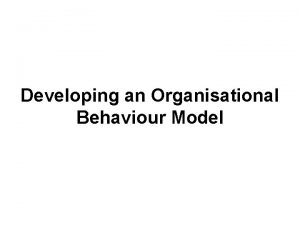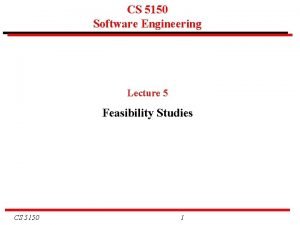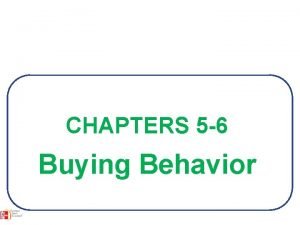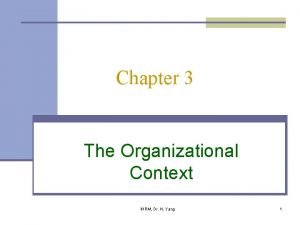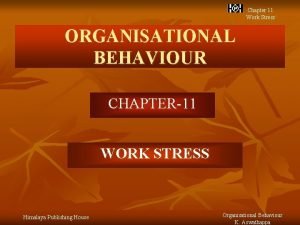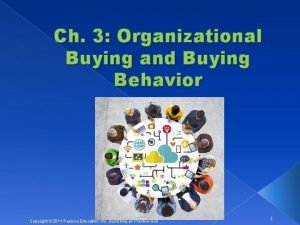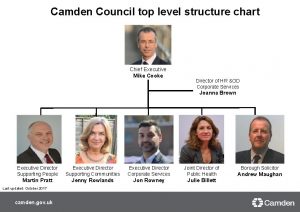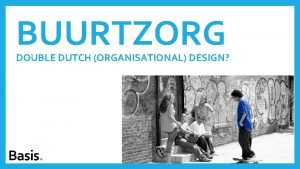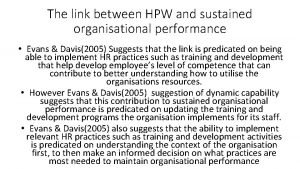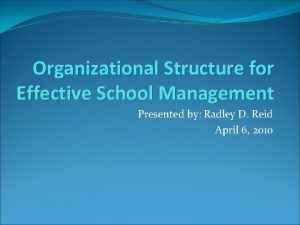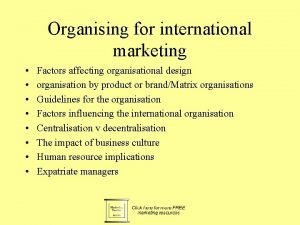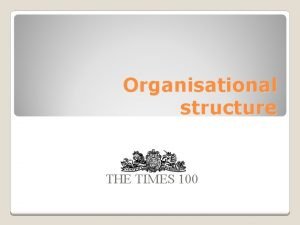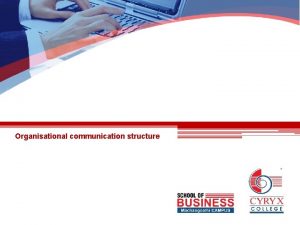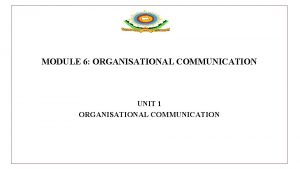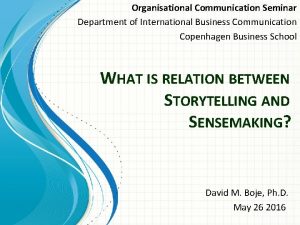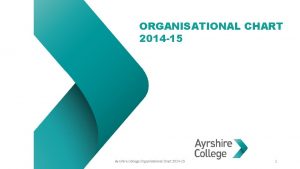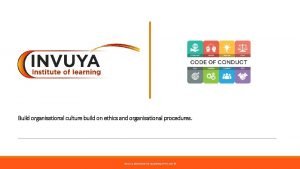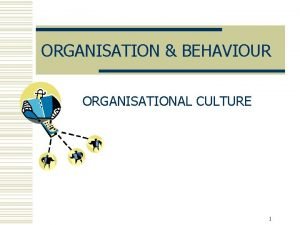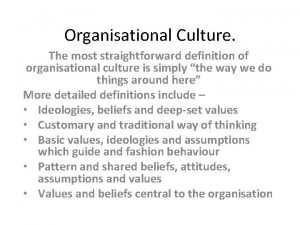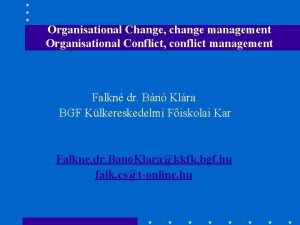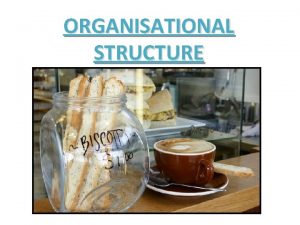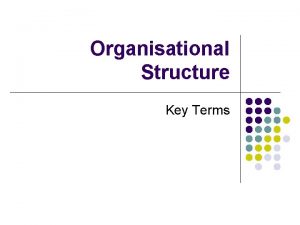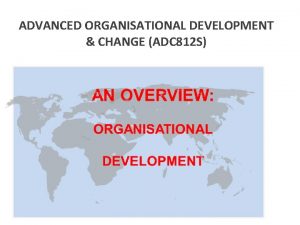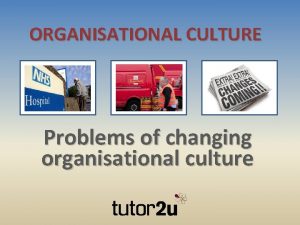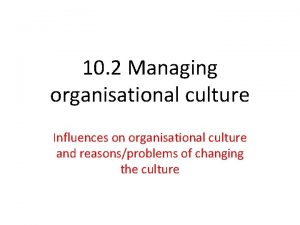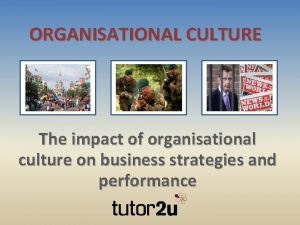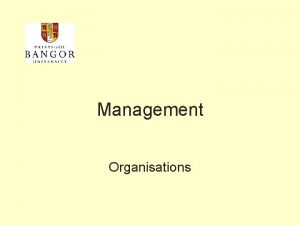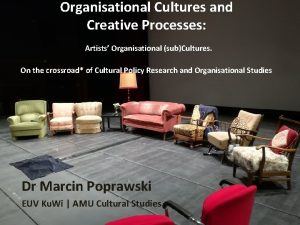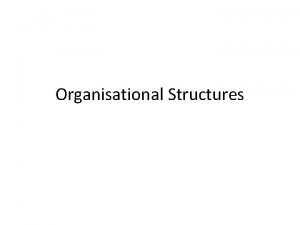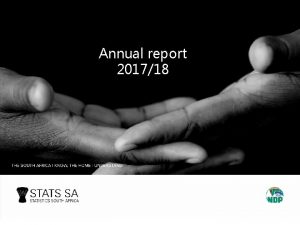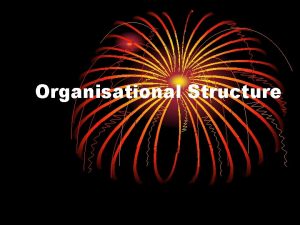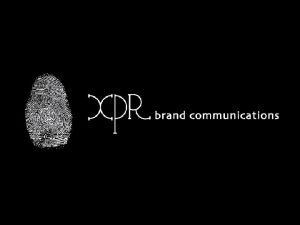Department of Communication Science Integrated Organisational Communication COM





























































- Slides: 61

Department of Communication Science Integrated Organisational Communication COM 2602

http: //portal. joininvideo. com#/player/e 20 a 1003 -c 1 d 1 -4 c 6 a-8627 -93 b 385 b 071 c 5/1324 Link for Broadcast • If you missed the Broadcast you can watch it following the Link • Use Google Chrome to view the Broadcast http: //portal. joininvideo. com#/player/e 20 a 1003 c 1 d 1 -4 c 6 a-8627 -93 b 385 b 071 c 5/1324

Your Lecturers Available between 08: 00 -16: 00. Ms Phumudzo Ratshinanga (Module coordinator) Theo van Wijk Building, Room 7 -85 : ratshpt@unisa. ac. za : (012) 429 – 4779 Mr Peter Masopoga Theo van Wijk, Room 6 -90 : : masoplp@unisa. ac. za : (012) 429 – 3143

Guidelines to prepare for exam

Reminder: Aim of the Module • After the module, you will possess both theoretical knowledge of integrated organisational communication • and the practical skills to promote the use of an integrated approach to organisational communication

Prescribed Material • Tutorial Letter 101/2018 • Tutorial Letter 301 (CMNALLE/301/4/2018) • Tutorial Letter 201/2018 (feedback and examination guidelines) • Only study guide for COM 2602 • Prescribed book: Angelopulo, GC & Barker, R. (eds). 2013. Integrated organisational communication. 2 nd edition. Lansdowne: Juta.

Prescribed Book Study Guide

Exam guidelines • PLEASE note that these are just plain guidelines and do not really form the core of the exam. • This is to guide you to prepare for the exam • Take these into consideration when studying

Examination Preparation • Read through the prescribed chapters and corresponding study units. Complete all activities. • Chapters 1, 2 and 12 of the P/book are relevant. • Limited time – two hours in which to answer ALL FOUR questions, (total of 100 marks). • Consists of shorter and longer essay-type questions only. Answers must be short enough for the time allowed, but cover every aspect of the question.

Exam Structure • Structure is same as assignment 1 • Will focus on important outcomes of each Study Unit • Will have the same mark allocation as assignment • Revise you assignments thoroughly • Do you have any questions from the assignment?

Examination Preparation Four questions – Answer All • STUDY UNIT 1 – Communication in the organisation 25 marks • STYDY UNIT 2 –The Rationale for integrating organisations’ communication 25 marks • STUDY UNIT 3 – Communication Integration Principles and Processes 25 marks • STUDY UNIT 4 – Integrated Communication Measurement 25 marks Total: 100

Important key/action words • Understand the Action words of the question • Explain: Justify and clarify to ensure that the reader clearly understands your arguments. Make use of illustrations, descriptions or simple but logical explanations. • Discuss: Elaborate on a topic by examining its various aspects. A critical approach should be followed.

Key/action words • Define or give the definition: Give a short and concise description of the subject or concept. • Describe: Give a detailed account of the characteristics of a topic. This should be done in a logical and well-structured manner. • Identify: List the most important characteristics of a topic.

Study Unit 1 Communication in the Organisation Angelopulo, GC & Barker, R. (eds). 2013. Integrated organisational communication. 2 nd edition. Lansdowne: Juta. Chapter 1 (pages 3 – 39)

In this Unit • You learnt of communication in the context of the organisation • You distinguished between the various fields of communication in the organisation and recognised the relationships between these fields

Unit 1: Communication in the Organisation • Fields of communication in the organisation • Relationships between fields • The strategic role of communication

Fields of Communication We look at the origin, emphasis, areas of interest, means and objectives of the fields See also page 26 -28 of the prescribed book

Fields of communication • It is important that you are able to distinguish between these fields • You will have to look beyond across traditional disciplinary boundaries for solutions.

The strategic role of communication • The concept of strategy • You will have to discuss the concepts • You will need to understand them to be able to provide examples § Defining strategy

Continued… • Extensions of the strategic concept § § Strategic management Strategic planning Strategic thinking Strategic decision making • Levels of strategy • The relationship between strategy and communication

STUDY UNIT 2 - THE RATIONALE FOR INTEGRATING ORGANISATIONS’ COMMUNICATION Chapter 2 (pages 40 - 72)

In this Unit • Communication integration processes are explained analysed • For you to apply what you know about the processes of communication integration in real and simulated contexts (We will ask you to provide examples). • For you to show that think independently and support your decisions (from the examples provided)

Outcomes of the Unit • Define communication integration and its elements § Understand its evolution • Describe communication integration • Identify the benefits of communication integration • Establish the reasons for integrating messages from all sources

Defining communication integration Communication integration is the crossfunctional process of creating and nourishing strategically determined relationships with stakeholders by ensuring that the messages to these groups are as appropriate and beneficial to the business relationship as possible, and engaging in purposeful dialogue with them.

Elements of this definition Cross-functional process – This involves the organisation as a whole, all departments. Creating and nourishing strategically determined relationships – entities that are determined as being necessary to the long-term success of the organisation Stakeholders – Communication integration has moved away from the traditional marketing focus on customers only, to including a broader spectrum of interest groups Controlling or influencing all messages – This entails actively managing messages not only originating within the organisation but also those without Engaging in purposeful dialogue – This entails a relational approach, where organisation and stakeholder work together for mutual benefit

Guidelines • For exam focus on : Align messages from all sources and Duncan’s Reason to move to an integrated perspective.

Duncan (2002) • Be able to identify the reasons for the move towards an integrated perspective on communication. • Be able to name and provide examples

Duncan (2002) • Three primary areas where change and evolution have led to the need for integration: - External market trends, - Trends within organisations and - Societies’ demands for organisational integrity.

Align messages from all sources It is important to consider the following four message sources: planned, product, service and unplanned messages. You need to be able to discuss them and their role in integration

Planned messages • Delivered through the traditional communication mix (marketing communication, PR and marketing PR, sales promotion, direct marketing and personal selling), and are delivered exactly as the organisation intends. • Eg. An advertisement on television

Product messages • Inferred from and comprise everything embedded in the product itself • Eg. Camera quality better than any other phone on the market is a unique selling point of new phone’s latest handset.

Service messages • These exist in the experience of dealing with the organisation and its staff, agents and products. • Eg. Quality of service at the repair centre. • Both product and service messages have greater impact because they are perceived as actual experiences.

Unplanned messages • These are generated beyond the reach of the organisation – such as rumours, word-ofmouth snippet and the content of media messages (eg. reviews in a technology magazine or website).

Planned messages are easiest for the organisation to plan and control, but they tend to have the least impact - often perceived to be biased. Service and product messages have greater impact because they are perceived as actual experiences of the organisation and what it does or produces. Unplanned messages are usually the most believable because their sources are generally perceived to be unbiased.

Integration exists when planned messages (what the organisation says) are confirmed by service and product messages (what the organisation does), and are further confirmed by unplanned messages (what unbiased observers say) about the organisation, its services and its products

For the organisation’s communication to be integrated, messages from all four sources must be similar, positive and strong. The challenge of integrating the communication of an organisation is to ensure that all messages about the organisation, its service and products, meet these criteria.

STUDY UNIT 3 COMMUNICATION INTEGRATION PROCESSES AND MANAGEMENT Chapter 2 (pages 40 - 72)

In this Unit • In this unit, arguments surrounding the rationale for communication integration are formulated in a logical and coherent way. • Communication integration processes and measurement are explained analysed

The management of communication integration • There are four methods and processes for the management of communication integration: – Rules or directives (common house styles, common starting points, and operational guidelines) – Sequencing – Routines – And group problem solving

Recognise the limitations and avoid the pitfalls Communication integration has its limitations, and to achieve all that is possible through integration it is necessary to consider these.

It is important to be aware of a number of pitfalls that may inhibit the success of an organisation’s communication and its successful integration.

Let us look at the following… The illusion of control; that integration lies with the receiver, not the organisation; absence of communication; the time perspective of various types of communication; and the impact of unplanned communication.

The illusion of control Communication integration implies the ability of the organisation to understand all of the factors that determine its relationship with its stakeholders, and to be able to control them. In reality, however, the ability of organisations to achieve this is always only partial – they may do so only some of the time and only to a certain degree. The ideal of total control over communication and its effects is illusory.

The view that managers have of their organisation is at best a type of map that can never reflect the organisation in all its complexity.

The span of communication that the organisation controls is never the complete range to which stakeholders are exposed. They will always acquire different perspectives on the organisation, from sources other than the organisation, and the organisation has very little control over these alternative message sources.

Integration lies with the receiver, not the organisation As much as communicators orchestrate their organisation’s communication, perception of this communication is ultimately integrated in the minds of its recipients. No matter how carefully formulated they may be, an organisation’s messages may be perceived very differently by its stakeholders.

Absence of communication In many cases where stakeholders require information on an organisation, the organisation remains silent and does not communicate. This is often the case when problems, emergencies, crises, or events where the organisation is cast in a poor light, arise.

In certain circumstances the decision not to communicate acts as a message in itself - particularly in the case of a problem or crisis. Stakeholders often view an organisation that avoids communication as untrustworthy, uncaring about its publics, or lacking respect. It is often better to convey negative information than not to communicate at all.

The impact of unplanned communication Planned communication is intended to yield certain results. An unforeseen outcome of such communication may be unplanned messages, which could have a positive or negative effect.

In the context of integration, it is important to consider unplanned messages when planning and evaluating the communication of an organisation.

The time perspective of various types of communication In planning communication activities it should be understood that all communication affects perceptions. If short-term campaigns clash conceptually with long-term campaigns, the perceptual effect is negative. In the same way, communications that have different objectives through time also need to be coordinated.

Study Unit 4 INTEGRATED COMMUNICATION MEASUREMENT Chapter 12 (pages 426 - 445)

Aims of the Unit • You will learnt about the processes and measurement of communication integration in real and simulated contexts. • The evaluation of the integration is dicussed in detail

The key questions that you need to consider while working through this study unit are as follows: • What models of integrated communication already exist and how do these models contribute to our understanding of integrated communication? • What concepts in the existing models can be used as criteria for the evaluation of integrated communication? • What integrated communication research methods already exist and what are their contributions and shortcomings? • How can traditional and online research be integrated? • What should a comprehensive model for the measurement of integrated communication entail?

Key concepts include • Duncan and Moriarty's model • Van Riel's model • Ehlers's model • Dimensions of integrated communication evaluation: process, output and outcomes • The IM audit • The stakeholder relationship audit • Traditional and online research • measuring integrated communication

Stakeholder Relationship Audit • Attitudinal survey research is used to measure stakeholders’ perspectives of how they view their relationship with the organisation. • It comprises the following three phases: • Phase 1: identify key stakeholders and compile a list of key issues important each group.

• Phase 2: select a representative sample of each stakeholder group and ask four standard questions: how important are these issues in an excellent organization, how well does the organization perform on these issues, how well does their best competitors perform on the same issues, how can the organisation improve its performance?

• Phase 3: Responses to the first 3 questions in phase 2 are analysed to identify 2 gaps: Performance Gap (question 2 compared with question 1) and the Best Practice Gap (comparing question 2 with question 3).

Integrating traditional and online research • In the current era, information and communication technologies affect every aspect of people’s lives in general, and the functioning of organisations in particular • Explain the opportunities and challenges

Important always… • Take mark allocation into consideration. • Carefully read question and answer what is asked. • Give examples when asked and only discuss when asked to do so.

THANK YOU ALL!!
 Dậy thổi cơm mua thịt cá
Dậy thổi cơm mua thịt cá Cơm
Cơm What is your favourite subject in college and why
What is your favourite subject in college and why What is matter in integrated science
What is matter in integrated science Lonestar nursing application
Lonestar nursing application Conceptual integrated science explorations
Conceptual integrated science explorations Pearson physics
Pearson physics Integrated science lab experiments
Integrated science lab experiments High school 101 class
High school 101 class Brad karp ucl
Brad karp ucl Northwestern electrical engineering
Northwestern electrical engineering Computer science department rutgers
Computer science department rutgers Department of forensic science dc
Department of forensic science dc Ohio tpes
Ohio tpes Computer science department stanford
Computer science department stanford Mch fsu
Mch fsu Trimentoring
Trimentoring Department of computer science christ
Department of computer science christ Eacademics iitd ac in sportal login
Eacademics iitd ac in sportal login Webnis
Webnis Marketing chapter 14
Marketing chapter 14 Marketing communications process
Marketing communications process Designing and managing integrated marketing communications
Designing and managing integrated marketing communications Introduction to integrated marketing communication
Introduction to integrated marketing communication Integrated communication network
Integrated communication network Integrated communications services
Integrated communications services The sender of an integrated marketing communication
The sender of an integrated marketing communication Communications mix
Communications mix Transactional analysis in organisational behaviour
Transactional analysis in organisational behaviour Ouh organisational structure
Ouh organisational structure Alton towers business
Alton towers business The strategic position
The strategic position Group dynamics in organisational behaviour
Group dynamics in organisational behaviour Organisational structure of regional rural bank
Organisational structure of regional rural bank Red cross management structure
Red cross management structure Reasons for changing organisational culture
Reasons for changing organisational culture Organisational behaviour: an introduction
Organisational behaviour: an introduction Contributing disciplines to organisational behaviour
Contributing disciplines to organisational behaviour Expectancy theory
Expectancy theory In the sobc model o represents
In the sobc model o represents Organization structure of mnc
Organization structure of mnc What is group dynamics in organisational behaviour
What is group dynamics in organisational behaviour Domestic structures
Domestic structures Power in organisational behaviour
Power in organisational behaviour Kotak mahindra bank investor presentation
Kotak mahindra bank investor presentation Biographical characteristics in organisational behaviour
Biographical characteristics in organisational behaviour Organisational structure of ethekwini municipality
Organisational structure of ethekwini municipality Diagram of autocratic model
Diagram of autocratic model Software feasibility study example
Software feasibility study example Organisational buying process
Organisational buying process Organisational stress
Organisational stress Organizational context of ihrm
Organizational context of ihrm Work stress model in organisational behaviour
Work stress model in organisational behaviour Organizational buying behavior
Organizational buying behavior Martin pratt camden
Martin pratt camden Buurtzorg organisational structure
Buurtzorg organisational structure Types of organizational strategies
Types of organizational strategies Benefits of hpw
Benefits of hpw Self monitoring in organisational behaviour
Self monitoring in organisational behaviour Organisational structure of a school
Organisational structure of a school Factors affecting organisational design
Factors affecting organisational design Specsavers organisational structure
Specsavers organisational structure






